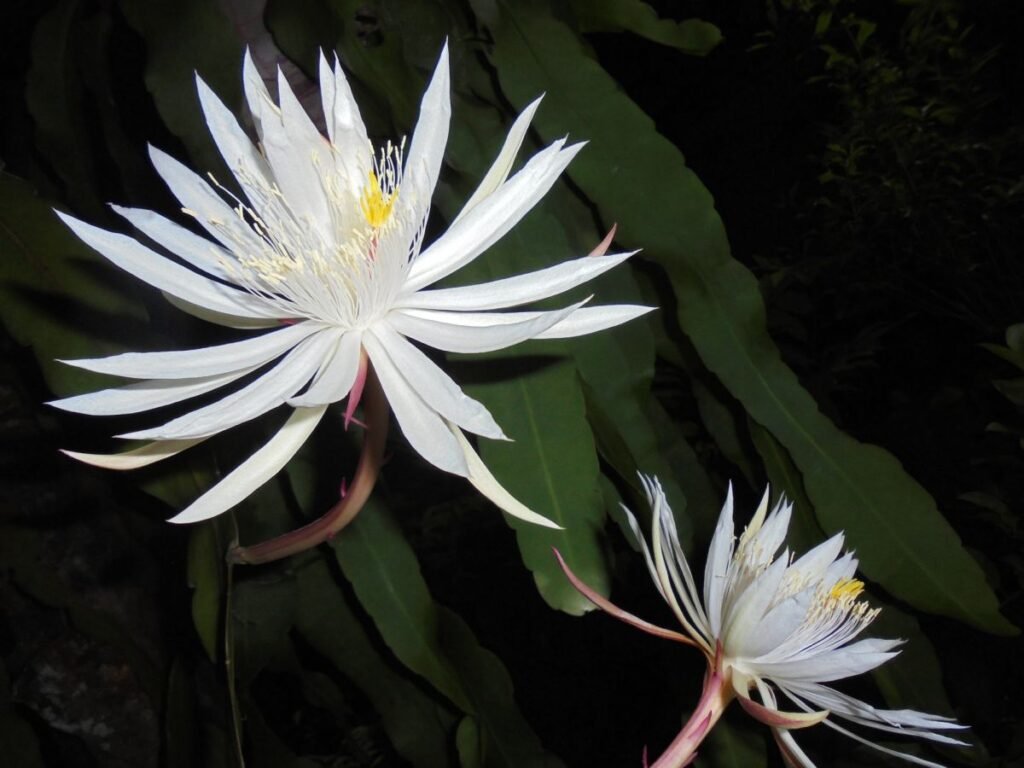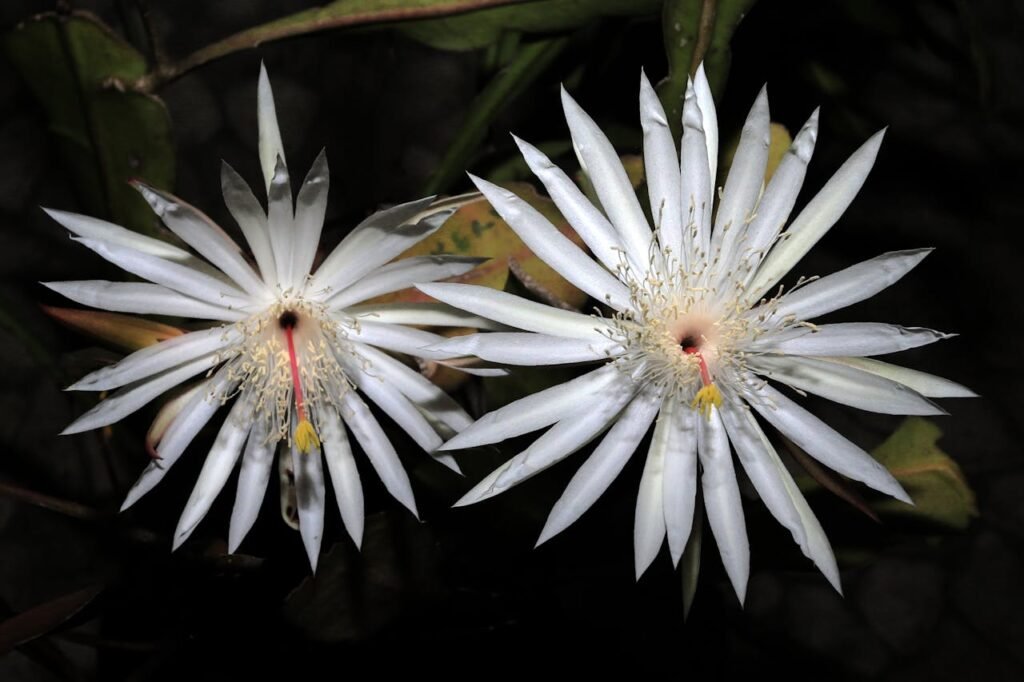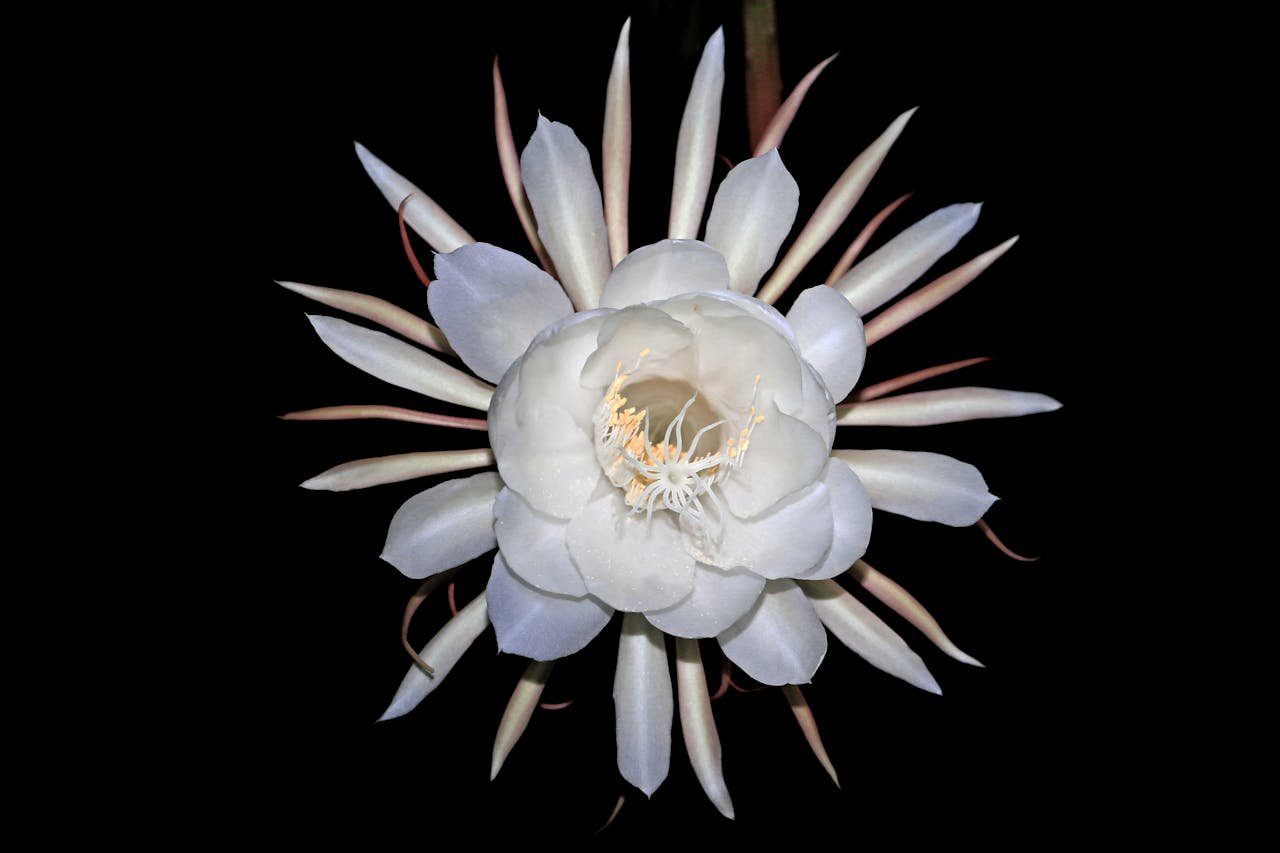Imagine a flower so shy that it blooms just once a year—and only at night. That’s the magic of the Queen of the Night cactus, also known as Epiphyllum oxypetalum. It’s not just another houseplant—it’s an event. For many, seeing this stunning cactus bloom under the moonlight is a gardening dream.
If you’re hoping to experience this moment in your own home, this detailed guide will walk you through everything you need to know. From light and watering to understanding dormancy and coaxing out those elusive blossoms, we’ll cover it all in a way that’s clear, beginner-friendly, and truly helpful.
Whether you’re nurturing a small cutting or caring for a mature specimen, this Queen of the Night cactus blooming guide will help you unlock its hidden beauty—one moonlit night at a time.
Understanding the Queen of the Night
What Is the Queen of the Night Cactus?
The Queen of the Night (Epiphyllum oxypetalum) is part of the cactus family but doesn’t fit the spiny stereotype. Native to tropical rainforests in Central and South America, it’s a climbing, epiphytic cactus with long, flat, leaf-like stems.
Its true claim to fame is its large, fragrant white blooms that open after sunset and close by dawn—usually just once a year. These night-only flowers are why it’s often called the night-blooming cereus.
Why Does It Only Bloom at Night?
In nature, blooming at night is a survival tactic. The cactus attracts nocturnal pollinators like moths and bats with its sweet fragrance and moon-glow appearance. The flowers are large, dramatic, and short-lived—lasting only a few hours.
Blooming Season and Frequency
- Most blooms happen between late spring and summer, especially in warm climates.
- Healthy plants may bloom once or twice a year, though first-time bloomers can take years.
Conditions for Successful Blooming
Ideal Lighting and Placement
Lighting is crucial for flowering. While this cactus isn’t as sun-hungry as desert types, it still needs the right exposure:
- Bright, indirect sunlight is ideal. A south-facing window filtered by sheer curtains is perfect.
- Outdoors, keep it in dappled shade under taller plants or on a balcony that gets morning light.
Too much direct sunlight may scorch the stems, while too little light can prevent blooming altogether.
Ideal Temperature and Humidity
The Queen of the Night thrives in warm, tropical conditions. Here’s what it prefers:
- Daytime temperatures: 21°C–32°C (70°F–90°F)
- Nighttime temperatures: No lower than 12°C (54°F)
- Humidity: Prefers 50–60%, but adapts well to normal household conditions.
If you live in a dry area, occasional misting or a pebble tray can help—especially during dry winters.
Soil Requirements
Use a loose, airy, and well-draining mix—just like its native rainforest roots.
- Use cactus mix + orchid bark or coco coir + perlite.
- Avoid heavy or compacted soil.
This cactus loves airflow around its roots and hates soggy soil.
Nurturing Toward Bloom
Watering Schedule for Bloom Encouragement
Getting this cactus to bloom means mastering a balanced watering rhythm.
- Water deeply but only when the top 2 inches of soil are dry.
- Spring to summer: Every 7–10 days.
- Fall to winter: Cut back to every 2–4 weeks.
Overwatering causes root rot, while underwatering can delay blooming.
Fertilizer Tips for Strong Blooms
Feed your Queen of the Night during the active growing season.
- Use a low-nitrogen, high-phosphorus fertilizer (like 10-30-20) every 4 weeks.
- Avoid fertilizing in winter during dormancy.
Phosphorus supports flower production, while too much nitrogen leads to leafy growth only.
Dormancy Period
Dormancy is essential for bloom readiness.
- In late fall, reduce watering and stop fertilizing.
- Place in a cooler spot with indirect light.
- This rest period lasts for about 8–10 weeks and signals the plant to prepare for blooming.
Without this break, the cactus may not bloom the following season.
When the Magic Happens – Bloom Time
How to Know a Bloom is Coming
Watch for these signs:
- Tiny buds forming along stem notches.
- Buds gradually enlarge and elongate over a few weeks.
- On bloom night, the bud will slowly begin opening after sunset.
By midnight, the flower is fully open, releasing a strong, sweet fragrance.
What to Do on Bloom Night
- Avoid moving the plant—bud drop is common with stress.
- Keep the room quiet and dim—harsh indoor light may interfere.
- Watch and enjoy—the bloom lasts only a few hours!
Some growers even throw “bloom parties” for this rare event.
Caring for the Plant After Bloom
Once the bloom wilts (by early morning), gently remove it. Continue normal watering and feeding to encourage new growth and future blooms.
Propagation: Growing More Queens

Propagating your Queen of the Night cactus is one of the most rewarding parts of owning this majestic plant. Not only does it help you grow your collection, but it also allows you to share this incredible cactus with fellow plant lovers. And the best part? It’s easier than you might think.
When to propagate:
The ideal time to propagate is in early spring, just before the growing season kicks in. This gives the cutting ample time to establish roots and develop during the warmer months.
Steps to propagate successfully:
- Select a healthy stem segment about 8 to 12 inches long. Choose one that is mature but not too woody or old.
- Use a clean, sharp knife or pruning shears to make a clean cut. Let the cutting rest in a dry, shaded area for 3 to 5 days. This allows the cut to callous over—essential to prevent rot.
- Plant the calloused end in a well-draining mix—a combination of cactus soil, perlite, and a bit of orchid bark works well.
- Place the pot in bright, indirect light and avoid watering for the first week. Mist lightly every few days until roots develop, which may take 2 to 4 weeks.
- Once roots form, resume a gentle watering routine and watch it grow!
Tip: Propagated plants may take a couple of years to bloom, but with proper care, they will eventually reward your patience with their own magical flowers.
Maintenance: Keeping Your Queen Happy Year-Round

While the Queen of the Night cactus isn’t demanding, a little routine maintenance goes a long way in ensuring it stays healthy and bloom-ready. Here’s what to keep in mind throughout the year:
Spring and Summer (Active Growth):
- Water when the top two inches of soil feel dry.
- Fertilize monthly with a bloom-boosting fertilizer.
- Monitor for new growth or budding signs.
- Wipe down leaves to remove dust and allow better light absorption.
Fall (Transition to Dormancy):
- Begin to reduce watering frequency.
- Stop fertilizing entirely by late fall.
- Move the plant to a slightly cooler, dimmer location to signal dormancy.
Winter (Rest Period):
- Water sparingly—just enough to prevent the plant from shriveling.
- Avoid repotting, pruning, or disturbing the plant.
- Let it rest so it has the energy to bloom next season.
Pruning and shaping:
After blooming or during early spring, lightly prune the cactus to shape it and remove any leggy or damaged stems. Always use sterilized tools to avoid spreading bacteria or fungi.
Practical Tips for Everyday Success
If you’re new to growing tropical cacti or just want to get the most from your Queen of the Night, these tried-and-true tips can help simplify care and set your plant up for a spectacular bloom:
1. Let the plant feel at home.
Don’t move it too often. Once you find a bright, indirect spot, leave it there—especially during budding season. Moving it can shock the plant and cause bud drop.
2. Mist occasionally during hot weather.
While it doesn’t need high humidity, the occasional misting on hot days mimics its tropical environment and keeps the leaves fresh.
3. Use a clay or terracotta pot.
These porous materials help prevent overwatering and allow better airflow to the roots.
4. Watch for signs of stress.
Yellowing or wilting leaves may indicate root issues, poor drainage, or too much direct sun. Always inspect the plant regularly.
5. Share the bloom!
When your plant is about to bloom (often in the evening), invite friends or family to witness the spectacle. Some growers even set reminders to stay awake for the short-lived event!
6. Don’t rush the bloom.
If your plant hasn’t bloomed in a few years, don’t panic. As long as it’s healthy and getting the right care, it’s simply building energy for that unforgettable night.
Common Problems and How to Avoid Them
Even resilient plants like this one have their issues. Here’s what to watch for:
- Bud Drop: Caused by sudden changes in lighting, watering, or moving the plant.
- No Blooms: Usually due to insufficient light, no dormancy, or overfeeding with nitrogen.
- Yellowing or Mushy Stems: Indicates overwatering or poor drainage. Check roots for rot.
- Pale, leggy growth: A sign of not enough light. Move closer to a bright window.
Solution Tip: When in doubt, simplify care—don’t overwater, don’t overfeed, and give it time to rest.
Pests and Diseases
While generally hardy, the Queen of the Night cactus can attract:
- Mealybugs: White, cotton-like clumps on stems.
- Spider mites: Fine webbing, especially in dry air.
- Fungal issues: Overwatering or poor air circulation.
Solutions:
- Use neem oil or insecticidal soap for pests.
- Improve ventilation and reduce watering to prevent fungus.
- Quarantine any new plants before introducing them nearby.
Using Mulch and Shade to Protect Plants (If Outdoors)
For outdoor growers in warm climates:
- Use organic mulch like coconut coir or bark to protect roots and retain moisture.
- During extreme sun or heat waves, use shade cloth or light fabric covers to prevent sunburn and water stress.
This helps simulate the filtered jungle canopy they prefer.
Design Ideas: Styling with Queen of the Night Cactus
This plant’s dramatic shape and large blooms make it a striking indoor or outdoor feature.
- Hanging baskets: Show off its trailing stems elegantly.
- Climbing support: Use trellises or bamboo stakes to guide vertical growth.
- Large ceramic planters: Pair with moss or pebbles for a refined look.
- Combine with other epiphytic or jungle plants for a lush, rainforest-style corner.
Its graceful, sculptural stems add a unique aesthetic—especially in minimalist or boho-themed interiors.
Is Queen of the Night Cactus Toxic?
Good news for pet parents and plant lovers—Queen of the Night cactus (Epiphyllum oxypetalum) is generally considered non-toxic to cats, dogs, and humans. That makes it a safer choice for homes with curious pets or toddlers who like to explore their surroundings.
However, while it’s not classified as poisonous, it’s still wise to discourage chewing or ingestion. The thick, fleshy stems might upset a pet’s stomach if eaten in large amounts, and the plant could suffer damage as well. For peace of mind, placing it on high shelves, in hanging baskets, or plant stands is a good idea if you’ve got furry roommates.
Unlike some houseplants like Sago palm or Dieffenbachia, the Queen of the Night doesn’t release toxic sap or contain harmful alkaloids. Still, always double-check with your vet or the ASPCA plant database if you’re unsure about any specific plant in your collection.
Invasiveness: Should You Worry?
Invasiveness isn’t a big concern when it comes to the Queen of the Night cactus, especially in indoor settings. It’s a relatively slow to moderate grower and behaves well in pots. You won’t find it spreading aggressively or taking over your space like some other fast-growing succulents or vines.
However, in outdoor tropical or subtropical climates, this plant can become more vigorous. If planted in the ground with ideal conditions (plenty of humidity, warmth, and indirect sun), it may begin to spread or climb rapidly, especially if not pruned regularly. While it doesn’t usually displace native flora, it can overtake nearby structures, fences, or trees if left unchecked.
For indoor gardeners or apartment dwellers, the Queen of the Night stays tame and manageable. A little routine trimming and repotting goes a long way in keeping it elegant and under control.
So no, you generally don’t need to worry about invasiveness—just keep an eye on its growth if you’re letting it sprawl outside.
Drought and Salt Tolerance
While the Queen of the Night cactus may look delicate with its slender stems and dramatic blooms, it’s impressively resilient when it comes to water stress. This epiphytic cactus has evolved to store moisture in its stems, allowing it to survive extended dry periods, which makes it ideal for apartment dwellers or busy plant owners.
However, unlike desert cacti, Epiphyllum oxypetalum prefers slightly more regular watering—especially during the active growing season. It doesn’t enjoy bone-dry soil for too long, but it’s forgiving if you forget once or twice. That said, overwatering is still a bigger threat than drought.
In terms of salt tolerance, this species is moderate at best. If you’re using tap water with high mineral or salt content, it’s a good idea to use filtered or distilled water occasionally to prevent salt buildup in the soil. This helps keep the roots healthy and prevents leaf tip burn or stunted growth.
For Dubai or other arid regions, protecting it from harsh saline winds or using clay pots that encourage mineral buildup drainage can also be helpful. In short, while not the most salt-hardy cactus, it manages well under moderate indoor conditions.
Uses and Benefits

The Queen of the Night cactus is more than just a pretty plant with a mysterious bloom. It brings several practical and aesthetic benefits to your home and garden:
- Ornamental Value: Its long, flat, trailing stems make it perfect for hanging baskets, vertical gardens, or decorative pots. Once it blooms, it becomes an instant focal point.
- Night Bloom Drama: The once-a-year blooming cycle builds excitement. For plant lovers, watching this cactus bloom becomes an annual event to look forward to—often at night, under moonlight.
- Mood Enhancement: Caring for this plant and catching it bloom can bring joy, peace, and mindfulness. Its dramatic transformation from plain stems to vibrant blossoms is deeply rewarding.
- Air Purifying Qualities: Like most succulents and cacti, it contributes to better indoor air quality by helping filter pollutants and increasing oxygen levels.
- Conversation Starter: Its unique bloom habits and fleeting flowers make it a topic of interest among gardeners and casual visitors alike.
While it may not have medicinal or culinary uses like other succulents (such as Aloe Vera or Nopal), its value lies in its beauty, symbolism, and calming presence—a true star of any indoor jungle.
FAQs
Q1: How long does a Queen of the Night flower last?
Only a few hours! It opens after sunset and closes by early morning. Be ready to enjoy it the night it happens.
Q2: How old does the cactus need to be to bloom?
Usually 3–5 years old. Blooms only come from mature stems, so patience is key.
Q3: Can I keep it outside all year round?
Only if you live in a tropical or subtropical climate. Otherwise, bring it indoors when temperatures drop below 12°C (54°F).
Q4: Can I force my plant to bloom?
No, but you can encourage blooming by mimicking its natural cycle—provide bright indirect light, limit watering during dormancy, and feed with a high-phosphorus fertilizer in spring.
Final Thoughts
The Queen of the Night cactus is one of those plants that offers more than just aesthetics—it offers an experience. Its mysterious bloom, unpredictable nature, and elegant growth pattern make it one of the most cherished succulents among collectors and indoor gardeners.
Though it asks for a bit of attention—right lighting, well-draining soil, and patient observation—what it gives in return is truly magical. Even if it takes a couple of years to bloom, the payoff is worth the wait. It encourages us to slow down, observe, and appreciate the fleeting moments of beauty in nature.
Whether you’re a seasoned cactus collector or a beginner who simply wants a plant with a story, the Queen of the Night will not disappoint. Just remember: the bloom may last one night, but the memories it creates will linger for a lifetime.
